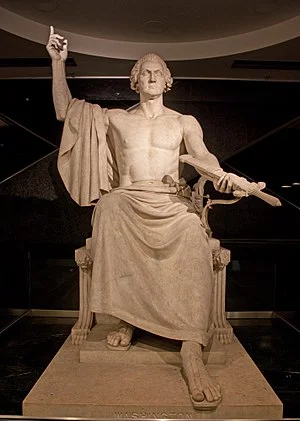Augustus or Cincinnatus
Augustus or Cincinnatus
On October 16th, 2019 in a press conference with Italian President Mattarella, US’ President Donald Trump said,
“The United States and Italy are bound together by a shared cultural and political heritage dating back thousands of years to ancient Rome.”[1]
Federal comes from the Latin word, “Foedus,” meaning league or treaty. The foederati were allies of the Romans. For example, the city of Naples was an independent state allied to Rome by a treaty and not under the actual rule of the Roman Republic.[2] Of course, the degree of independence changed with time and circumstance and may have been more nominal than actual for certain foederati. A later example of foederati were the Visi-Goths (Western Goths), who fought with the Western Roman Empire against Attila the Hun at the battle of Chalons in 451 AD.
The US Constitution was modeled after the Romans. The newly independent states did not want to give up the status that they had fought for as “free and independent states,” per the Declaration of Independence and the 1783 Treaty of Paris. The founders looked to a system that would be long lasting and unifying, hence the term Federal.
Indeed, in his notes on the Constitutional Convention, dated July 23rd 1787, James Madison writes,[3]
“Mr. Govr. Morris moved that the reference of the plan be made to one general Convention, chosen & authorized by the people to consider, amend, & establish the same. - Not seconded.”
Hence, Article VII of the US Constitution states,
“The Ratification of the Conventions of nine States, shall be sufficient for the Establishment of this Constitution between the States so ratifying the Same.”
The Roman Republic lasted from 509 BC (244 AUC)[4] with the expulsion of their Etruscan monarch until 27 BC (726 AUC) when Octavian (Caesar Augustus) became elected Consul and Proconsul- amongst other extraconstitutional titles and powers, such as imperator (emperor)- until his death is 14 AD (767 AUC). However, the Senate and functions of the Republic existed beyond the creation of the Roman Empire, even as the Senate decreased in power until it was last mentioned in Rome in 603 AD, 127 years after the official end of the Western Roman Empire.[5]
The Roman Senate continued to exist in the new Roman capital of New Rome when it was renamed from Byzantium by the Emperor Constantine in 330 AD. New Rome was popularly called Constantine’s City (Constantinople). The Senate lasted until until the fall of Constantinople to the Latin Crusaders in 1204 AD.[6] The Eastern Romans would eventually reconquer Constantinople in 1261 AD.
The Eastern Roman Empire would finally end in 1453 AD with the fall of Constantinople to the Ottoman Turks, whose Sultan, Mehmet II was declared Kayser-i Rum (Caesar of Rome).[7] The Grand Duke of Muscovy, Ivan IV titled himself Czar/Tsar (Caesar) in 1547 AD[8] and the King of Prussia, Wilhelm I, was even titled Kaiser (Caesar) in 1871 AD, along with the Holy Roman Emperors until Napoleon (Emperor des Français) ended the Holy Roman Empire (800 AD-1806 AD).[9] Emperor comes from the Latin word for [victorious] commander, “imperator.”
Like Constantine, Mehmet II, Ivan IV, and Wilhelm I, the American Founding Fathers wanted to create a New Rome. Similar to the Romans, the USA have existed as a Republic since the expulsion of the British monarch, King George III and his Parliament. The architecture of their new capital, Washington D.C. has buildings modeled after Roman architecture and a bicameral legislative body (like the British Parliament)- including a Senate.[10] Unlike the Emperor Constantine, the Founding Fathers did not want to recreate the Rome of the Caesars, but rather that of Cincinnatus. Many saw George Washington as a Cincinnatus, since he held much political power yet was eager to relinquish it to return to his farm- both after the war for independence and again after his second term in the office of presidency- as opposed to the Caesars who were content to be dictators for life.
Cincinnatus was a Roman Consul who was elected dictator in 458 BC to fight off an invasion and again in 439 BC.[11] He is famous for relinquishing his power early[12] and returning to his farm.
In Federalist 69, Alexander Hamilton, American Revolutionary officer, Secretary of the Treasury, and Vice President, wrote under the Roman pseudonym Publius,[13]
“Secondly. The President is to be commander-in-chief of the army and navy of the United States. In this respect his authority would be nominally the same with that of the king of Great Britain, but in substance much inferior to it. It would amount to nothing more than the supreme command and direction of the military and naval forces, as first General and admiral of the Confederacy; while that of the British king extends to the DECLARING of war and to the RAISING and REGULATING of fleets and armies, all which, by the Constitution under consideration, would appertain to the legislature.”
There are numerous examples of the USA being a New Rome. One of the most notable is how the Roman Empire declined. The first Emperor, Caesar Augustus, was called Princeps (first citizen) during his lifetime, as he wished to preserve the façade of the Republic. Today, the US have over extended themselves militarily because the president can invade countries at will, without needing the legislature to declare war, among other powers that have been given up by Congress.
The Romans debased their currency, increased taxes, and increased the power of the government over the lives of the governed, concentrating power in their commander (imperator) in chief.. The USA are doing the same today.
Is Donald Trump an Augustus, merely wanting to rule the façade of a Republic, or is he a Cincinnatus- a modern day George Washington- wishing to use his power to restore the Republic?
[1] https://sputniknews.com/viral/201910171077074331-donald-trump-gets-an-earful-after-saying-us-italy-ties-go-back-to-ancient-rome/
[2] http://penelope.uchicago.edu/Thayer/E/Roman/Texts/secondary/SMIGRA*/Foederatae_Civitates.html
[3] https://www.consource.org/document/james-madisons-notes-of-the-constitutional-convention-1787-7-23/
[4] AUC is an abbreviation for Ab Urbe Condita and means, “from the founded city.” The city being Rome in 753 BC.
[5] https://books.google.com/books?id=7VDcmDeLuV4C&pg=PA1047#v=onepage&q&f=false pg. 1047.
[6] Phillips, Jonathan (2004). The Fourth Crusade and the Siege of Constantinople. Penguin
[7] http://www.demturkishcenter.com/ottoman-sultans-fatih-sultan-mehmet/
[8] https://historyplex.com/history-timeline-of-russian-czars
[9] https://germany19001939.blogspot.com/2013/04/the-last-german-emperor.html
[10] https://www.washingtonpost.com/outlook/2019/09/17/why-knowing-roman-history-is-key-preserving-americas-future/
[11] https://www.britannica.com/biography/Lucius-Quinctius-Cincinnatus
[12] https://www.britannica.com/topic/dictator-Roman-official


